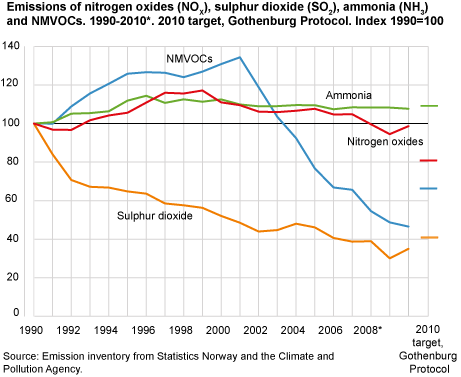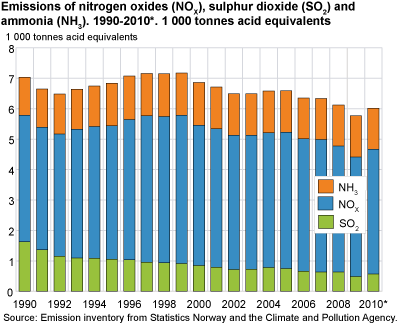Content
Published:
This is an archived release.
NOx obligations will not be fulfilled
Norway’s emissions of NOX increased by 4 per cent in 2010. This is 20 per cent above the obligations for 2010 set in the Gothenburg Protocol. The emissions of the other acidifying gases and NMVOC were however below the obligations.
These are the results in new calculations of preliminary figures for 2010 in the Norwegian emission inventory, which is compiled by Statistics Norway in collaboration with the Climate and Pollution Agency.
The emissions of the acidifying substances NOX, SO2, NH3 rose by 4 per cent in 2010, measured as acid equivalents . This was mainly due to the increase in SO2 emissions, which rose by 16 per cent. NOX emissions went up four per cent, while NH3 emissions fell less than one per cent.
Emissions of NMVOC (non-methane volatile organic compounds) continued the decline of recent years, and were reduced by 4.5 per cent in 2010. The emissions of carbon monoxide were about the same as in 2009.
| Gas |
Emissions 2010*.
1000 tonnes |
Change in emissions
since 1990. Per cent |
Emission ceiling 2010.
1000 tonnes |
Achievement of target1 | Harmful effects | ||||||||||||||||||||||||||||||||||||||||||||||||||||||||||||||||||||||||||
|---|---|---|---|---|---|---|---|---|---|---|---|---|---|---|---|---|---|---|---|---|---|---|---|---|---|---|---|---|---|---|---|---|---|---|---|---|---|---|---|---|---|---|---|---|---|---|---|---|---|---|---|---|---|---|---|---|---|---|---|---|---|---|---|---|---|---|---|---|---|---|---|---|---|---|---|---|---|---|---|
| Nitrogen oxides (NOX) | 189 | -1,4 | 156 | 32 500 tonnes (21 per cent) above target |
Increase the risk of respiratory disease (particularly NO2).
Contribute to acidification, corrosion and formation of ground-level ozone. |
||||||||||||||||||||||||||||||||||||||||||||||||||||||||||||||||||||||||||
| Sulphur dioxide (SO2) | 18 | -65 | 22 | Emission target achieved |
Increases the risk of respiratory complaints.
Acidifies soil and water and causes corrosion. |
||||||||||||||||||||||||||||||||||||||||||||||||||||||||||||||||||||||||||
| Ammonia (NH3) | 23 | 8 | 23 | Emission target achieved | Contributes to acidification of water and soils. | ||||||||||||||||||||||||||||||||||||||||||||||||||||||||||||||||||||||||||
| NMVOCs1 | 135 | -53 | 195 | Emission target achieved |
May include carcinogenic substances.
Contribute to formation of ground-level ozone. |
||||||||||||||||||||||||||||||||||||||||||||||||||||||||||||||||||||||||||
| CO1 | 319 | -57 | - | No quantified emission ceiling | Increases risk of heart problems in people with cardiovascular diseases. | ||||||||||||||||||||||||||||||||||||||||||||||||||||||||||||||||||||||||||
| 1Figure for "Change in emissions since 1990" and Achievement of target for Nitrogen oxides were corrected 26 May 2011 |
| Source: Emission inventory from Statistics Norway and the Climate and Pollution Agency. |
NOx emissions increased slightly …
Emissions of NOx(nitrogen oxides) increased by 4.5 per cent. Higher activity in the production of iron, steel and ferro-alloys contributed most to the increase. Other sources, such as coastal traffic, motorised equipment and energy supply were also important contributors to the increase.
Technical measures have been introduced to reduce NOX emissions, but they have not been sufficient to compensate for the increase in activities.
Important sources of these emissions in 2010 were road traffic (20 per cent), other transport and motorised equipment (39 per cent), and combustion in oil and gas-related activities (27 per cent).
… SO2 emissions increased substantially …
About 70 per cent of the SO2 emissions derive from the manufacturing industries. These emissions increased by 16 per cent in 2010, mainly due to higher activities in the production of iron, steel and ferro-alloys. Total SO2 emissions are still well below target, and were also lower than in 2008.
… NH3 and CO emissions were stable …
Around 90 per cent of NH3 emissions derive from agriculture, and most of this is from manure. The emissions from manure increased slightly, while emissions from use of fertilisers went down 20 per cent. This was due to changes in the types of fertilisers used. Total emissions were about the same as the year before.
Increased input of coal and coke in manufacturing industries brought about an increase in the emissions of carbon monoxide (CO), but this increase was counteracted by a decrease in emissions from petrol cars.
… while NMVOCs fell
The consistent trend in the last 10 years of reduced emissions of NMVOCs also continued in 2010, with a reduction of more than 4 per cent. Improved loading technology offshore has been the main cause, but in 2010 the reductions are linked to reduced production and consequently less oil loaded. Fewer petrol cars also contributed to smaller emissions.
About the emission inventoryRead more about:
|
See also emissions of greenhouse gases and national accounts and the environment published today.
Tables:
- Table 1 Emissions to air by source. 1990
- Table 2 Emissions to air, by source. 2008
- Table 3 Emissions to air, by source. 2009*
- Table 4 Emissions to air of NOX, SO2, NH3, NMVOCs and CO. 1973-2010*
- Table 5 Emissions to air of SO2, NOX, NH3, NMVOCsand CO, by industry. 2009. Tonnes
- Table 6 Emissions to air of SO2, NOX, NH3, NMVOCsand CO by industry. 2010*. Tonnes
The statistics is published with Emissions to air.
Contact
-
Statistics Norway's Information Centre
E-mail: informasjon@ssb.no
tel.: (+47) 21 09 46 42


